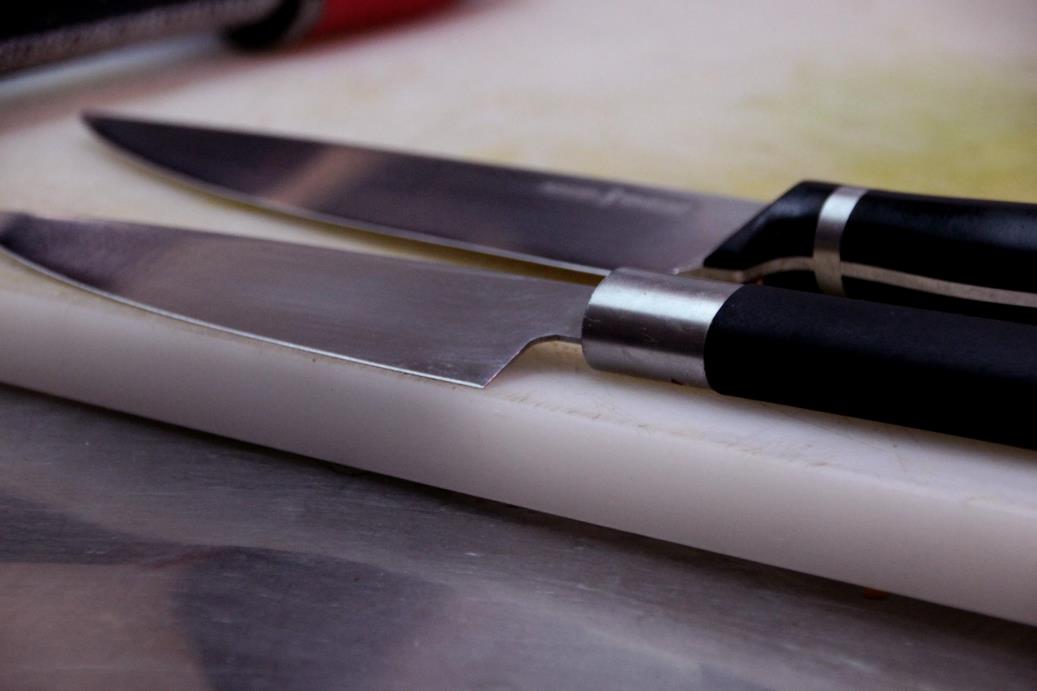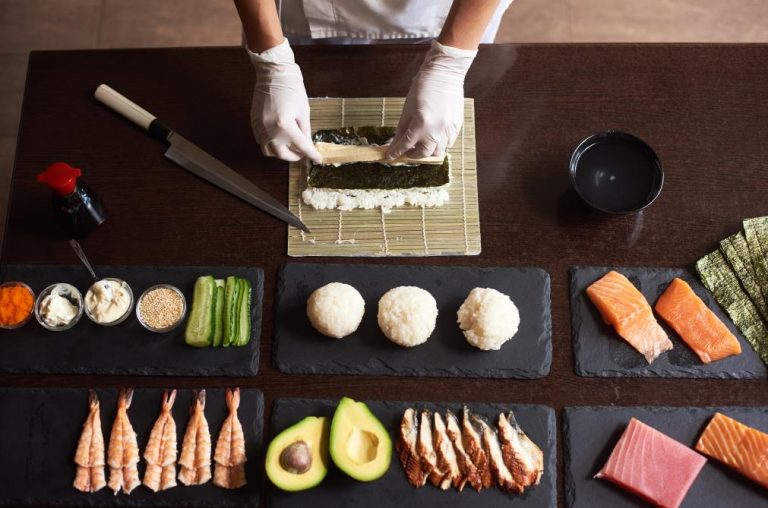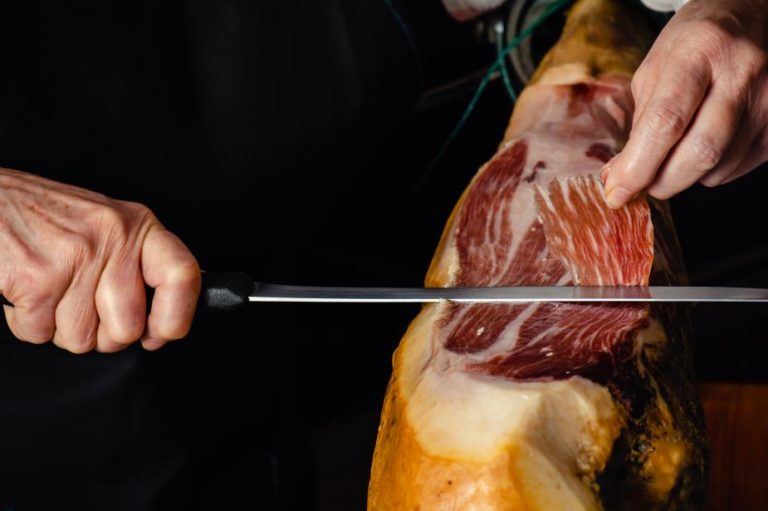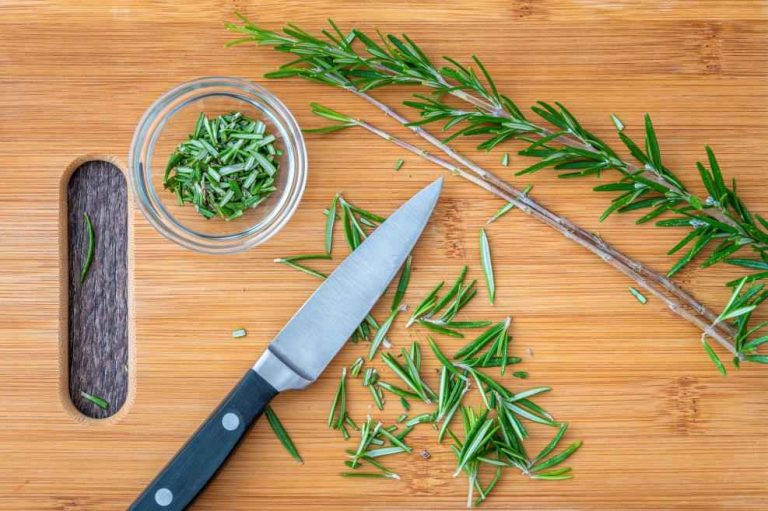Among the different types of blades used in a kitchen, most fall in the category of Japanese or German kitchen knives. When buying a new kitchen knife, your customers will need to choose between them.
In most cases, western and German knives are interchangeable. For this article, however, we’ll solely focus on the characteristic differences between German and Japanese kitchen knives. We’ll cover their features, types of steel used, handle materials, practices, and many more.
Use the navigation buttons on the left to skip to the parts that interest you the most.
Japanese kitchen knives
Let’s start with Japanese kitchen knives.
Forging a blade is nothing new to the Japanese, but kitchen knives, in particular, gained traction in the 1850s after Japan opened its doors. Since then, Japanese knives have slowly found their place in other parts of the world.
The primary Japanese kitchen knives, like the Yanagiba, used for preparing sashimi and slicing fish remained largely the same for hundreds of years. Not all Japanese blades are as old as this, though. There are newer additions to Japanese kitchen cutlery compared to much older blades influenced by the Western world, like the Gyuto, which is mainly for cutting red meat.
Common types of Japanese knives
While you might’ve heard of Gyuto or Yanagiba, there are many other types of Japanese kitchen knives used for various tasks in the kitchen. Here are some of the prominent examples of Japanese kitchen knives.
Santoku

Santoku or Santoku bōchō is an all-purpose kitchen knife comparable to a German chef’s knife. The primary difference is they aren’t as sturdy and more for creating sophisticated cuts. It’s relatively shorter than a standard chef’s knife at 8 inches of length at max.
Mainly used for chopping, dicing, mincing, and slicing, Santoku is an ideal knife for food preparation from start to finish.
Deba
Deba bōchō is the carving knife equivalent. However, it has an entirely different blade design with a tall profile and thick spine. Compared to the narrow, flexible blade of German carving knives, Deba is better suited for butchering and fileting medium and large-sized fish.
Like many other Japanese specialty knives, Deba bōchō has a single bevel edge – more on the bevel differences between Japanese and German knives below.
Petty
The Petty knife is the small Gyuto, often seen as the Japanese paring knife for peeling and slicing vegetables. It has lengthier options than a German paring knife, which measures around three to four inches, whereas the Petty can be up to 7 inches long.
This Japanese knife can serve the same purpose as a utility knife thanks to the longer blade than a paring knife.
Kiritsuke
Kiritsuke is an all-purpose knife, like Santoku, but its best ability is to slice ingredients finely. The blade design of Kiritsuke is a cross between Yanagiba and Gyuto. It has a relatively straight edge that chops and minces the best with up and down motions, known as push cutting.
Any cook can get used to the cutting style of Kiritsuke, but it’s a tad bit difficult at first. Kiritsuke is more appealing to professional chefs than home cooks due to the difficulty of use.
Kiritsuke is usually longer than other all-purpose Japanese kitchen knives, at 10 to 14 inches of blade length.
Sujihiki
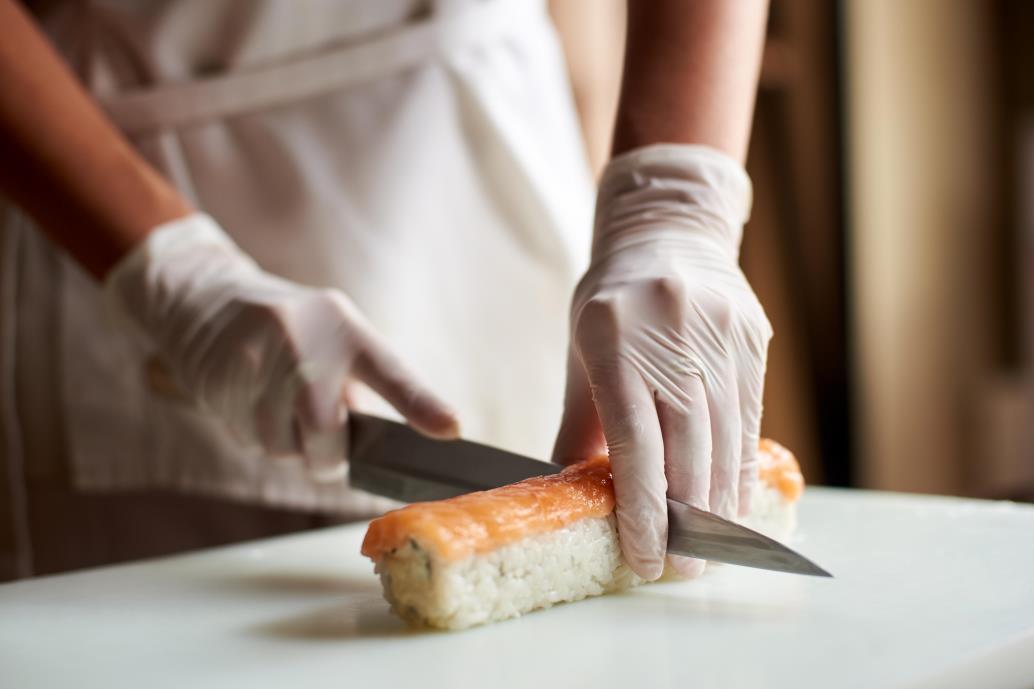
Sujihiki’s purpose is similar to Kiritsuke, but solely for slicing. This knife is more comparable to Yanagiba, used for fileting fish and slicing any boneless animal protein. It’s also excellent at carving meat and poultry with its long, narrow blade up to 16 inches.
Although it looks identical to Yanagiba, the sashimi knife, Sujihiki features a double bevel edge.
Main features of Japanese knives
Japanese knives have sharp, refined edges that slice smoothly without tearing the ingredients. Many famous Japanese dishes like sushi and sashimi require finely sliced fish. These are easier to do with a blade that’s ground only on one side with a sharp edge.
Additionally, the blade design of the Japanese kitchen knives complements these tasks. Since food sticking to the blade could cause it to tear apart due to the friction caused, slicing knives often have a narrow profile.
If it’s a single bevel knife, the blade width doesn’t matter as much. It most likely has a concave design on the flat part, contributing to food separation. The concave part of single bevel Japanese knives works the same as the Granton edge found in German-style blades.
To summarize, we can say:
- Japanese knives are incredibly sharp, with some ground on only one side.
- They come with different blade designs. Some have slim edges with a thick spine; some feature long narrow blades; some transform into a pointy triangular tip; and many more.
- Even the different all-purpose Japanese kitchen knives have specialties. For example, Kiritsuke slices, Santoku chops, and Gyuto do everything in between.
- Japanese knife blades are made from hard knife steels with a small grain structure for sharpness. The hard steels enable Japanese knives to retain a sharp edge for extended periods.
Continue reading to learn the differences in the handle, steel, forging, and blade design.
There are many Japanese kitchen knives for specific purposes. Take a look at our Japanese knives catalog to find the appropriate options for your customers.
Can’t find the type of Japanese knife you have in mind? Contact us with your ideas, and we’ll get back to you ASAP.
Buy Wholesale Knives and Start Scaling up with Us Today
Contact us and connect with a sales rep to get a free quote.
German kitchen knives
German knives influenced the western kitchen cutlery for hundreds of years.
Due to the culinary differences, German knives require sturdier blades as opposed to delicate yet incredibly sharp knives. For example, the heel of a German chef’s knife should be able to cut through tough cuts of meat, including bones.
German kitchen knives stand out with their toughness and ability to cut dense ingredients. In a way, as long as the knife cuts, the delicacy of the pieces isn’t as important. They will be cooked anyway and aren’t put on display the same as sashimi or sushi.
For these reasons, German knives are sturdy, heavy, and better suited for cutting dense ingredients.
Common types of German knives
There are many German blades used for different tasks, like Japanese kitchen knives.
Chef’s knife
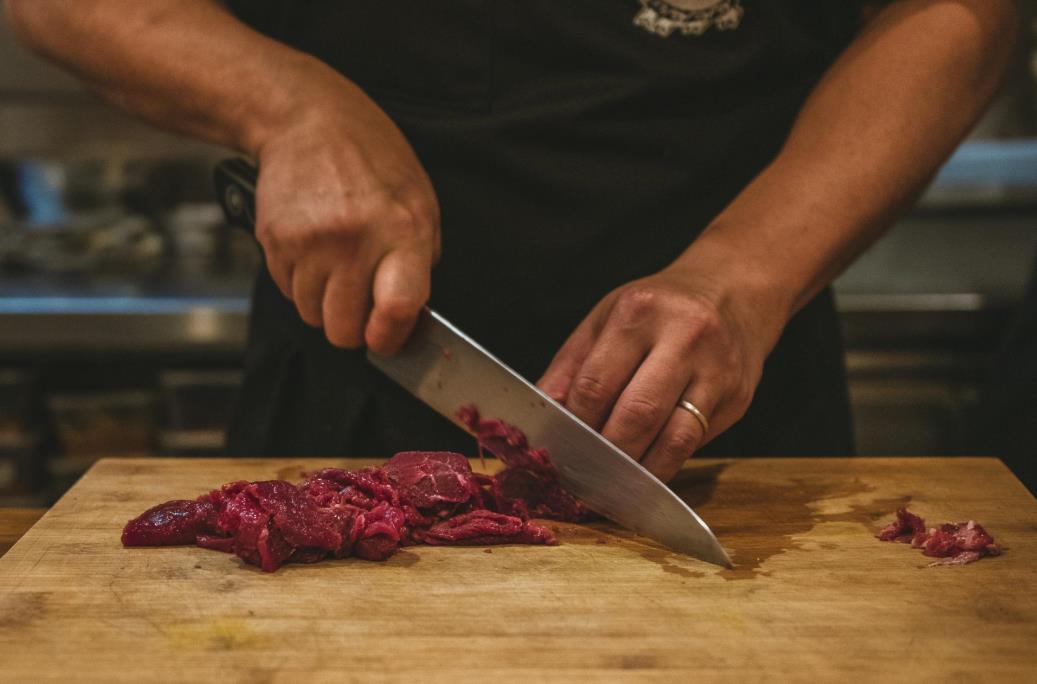
The most popular German kitchen knife of all, the standard chef’s knife, is able to tackle so many different tasks. It’s the most versatile knife cooks use across all parts of food preparation. Chef’s knives have many blade lengths and widths, suitable for the preferences of many.
If the cook is skilled enough, they won’t need to look for another blade. The only time a chef’s knife may not be adequate is for tasks that require a differently sized blade, like a paring knife.
Paring knife
With the most petite blade in this article, paring knives are essentially small chef’s knives, suitable for precision tasks like peeling. Its most common use is peeling and slicing vegetables and fruits
Any precision task requiring the cook to hold the ingredient in hand, like deveining shrimp or peeling vegetables, is the easiest with a paring knife with its small blade.
Boning knife
The narrow and flexible blade of a boning knife with a sharp tip enables it to separate meat from bones effortlessly, hence the name. The blade profile of boning knives is extremely thin and usually made from soft steel. These make boning knives have enough flexibility.
Whether cooked or raw, boning knives are ideal for maneuvering around the bones to cut through ligaments and connective tissue to separate meat. It’s one of the most commonly used German knives for butchering meat.
Utility knife
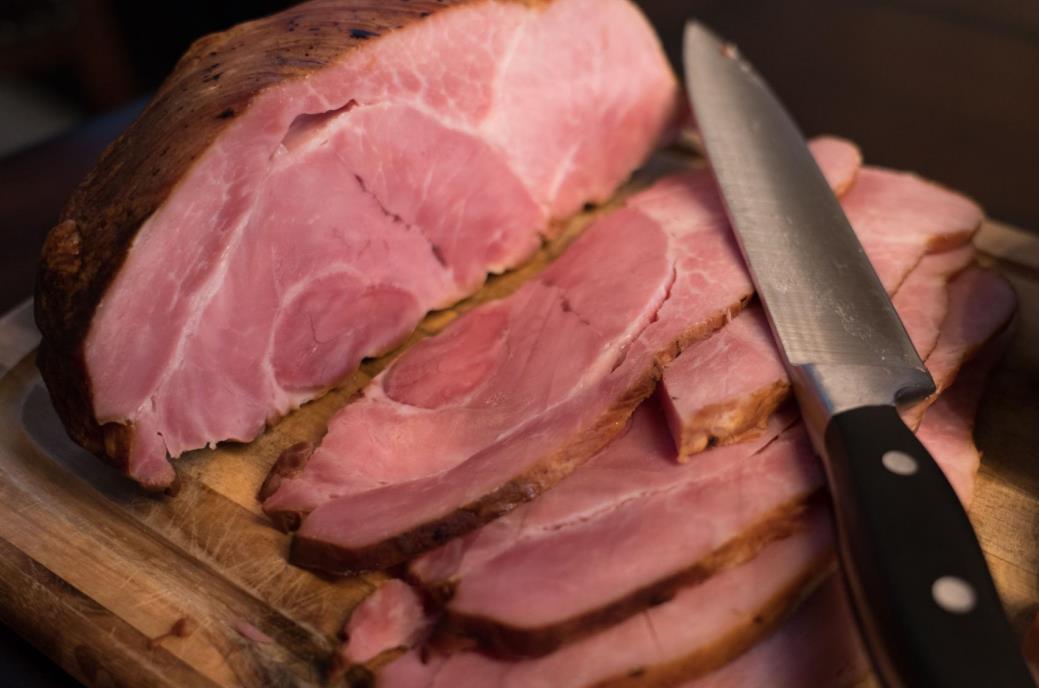
A utility knife is a merger between a typical chef’s knife and a paring knife. The use of this knife is more evident when a chef’s knife is too big, but a paring knife is also too small for the job.
The blade design is similar to a paring knife with a narrow structure. Utility knives also resemble a boning knife. The easiest way to distinguish them is by looking at the blade thickness and flexibility. Utility knives are thicker and don’t have a bend to them.
Bread knife
As the name suggests, bread knives are for cutting baked goods without damaging the outer crust and the soft inside. They have serrated edges that cut in a sawing motion. Therefore, the cutting style of bread knives is different from others on this list.
It isn’t just bread that these knives slice through easily. Using a bread knife to cut foods with a hard outside and soft inside, like melons and pineapples, will give the cook an easier time, thanks to its serrated edge.
Main features of German knives
German-style kitchen knives are versatile in many aspects and are sturdier. A chef’s knife is enough for most home cooks and professionals to get through the entire meal preparation.
For more specialized tasks, the others give an easier time. Using a boning knife to debone chicken thighs, a carving knife to break down a whole turkey, a paring knife to prepare fruit bowls, and a utility knife for everything with a smaller blade will save the cook time and effort.
To summarize, we can say:
- German knives are sturdy and versatile, with the chef’s knife being at the center of everything. It’s common for a professional cook to use their chef’s knife for all meal preparation steps.
- They are excellent at cutting meats in various ways.
- German knife blades have increased toughness due to the steel used. They are unlikely to chip but get dull faster compared to Japanese blades.
- Most German knives have a similar blade profile that facilitates chopping and slicing by rocking the blade.
German kitchen knives don’t have as much variety, but every blade has more than one use. This versatility is one of the reasons why many cooks favor them. See our western kitchen knives catalog.
Buy Wholesale Knives and Start Scaling up with Us Today
Contact us and connect with a sales rep to get a free quote.
Japanese vs. German steel
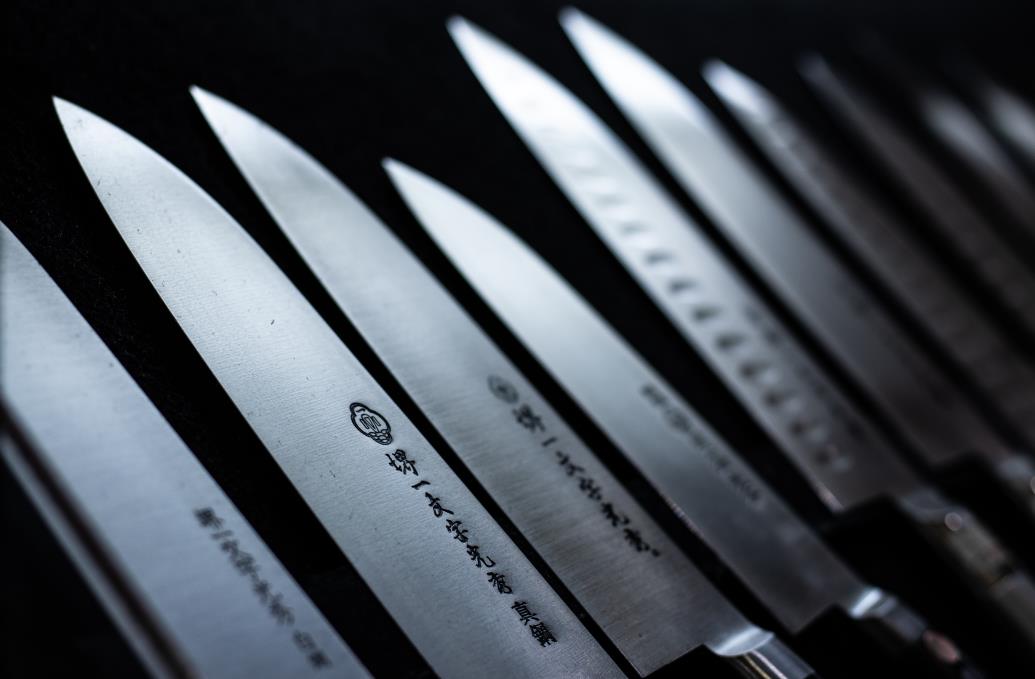
Japanese knives often use high carbon or high carbon stainless steel, whereas German knives use stainless steel. The reason for this is straightforward. Compare carbon steel vs. stainless steel here.
Western cuisines don’t require as much slicing. There is more chopping and mincing involved than slicing.
Japanese foods need more slicing than anything else. Various meals also require differently sliced ingredients. That’s why there is more than one slicing knife, such as Yanagiba, Sujihiki, and Kiritsuke.
All the chopping and mincing over the ingredients with fast movements can damage the edge. Added with heavy-duty cuts like going through bones and dense ingredients, soft steel is more favorable for German kitchen knives. The damages to the knife’s edge or the blade as a whole aren’t likely to happen with these types of steel.
The toughness soft steel gives to the blade is the primary reason why German-style kitchen knives are sturdier and more durable.
On the other hand, Japanese dishes favor a sharp blade that slices through ingredients effortlessly. With a sharp knife, the slices are always smooth with no tears. These are complementary to Japanese cuisine.
Accomplishing delicate cuts requires an incredibly sharp blade. At the same time, this requires hard steel with a fine grain structure. Many commonly used knife steel for Japanese kitchen knives fit this description.
Examples of Japanese & German knife steel
- VG-10 (Japanese): A premium-grade Japanese stainless steel, mainly found in high-end Japanese kitchen knives for professional chefs.
- AUS-8 (Japanese): One of the most corrosion-resistant Japanese steels, AUS-8 is preferred for making kitchen knives for home cooks.
- X50CrMoV15 (German): Incredibly corrosion resistant and tough, X50CrMoV15 is a staple for many German knife brands, like Wusthof.
These are just a few common Japanese and German steel used in knifemaking. Learn more about other types of knife steels.
Japanese vs. German knife handle
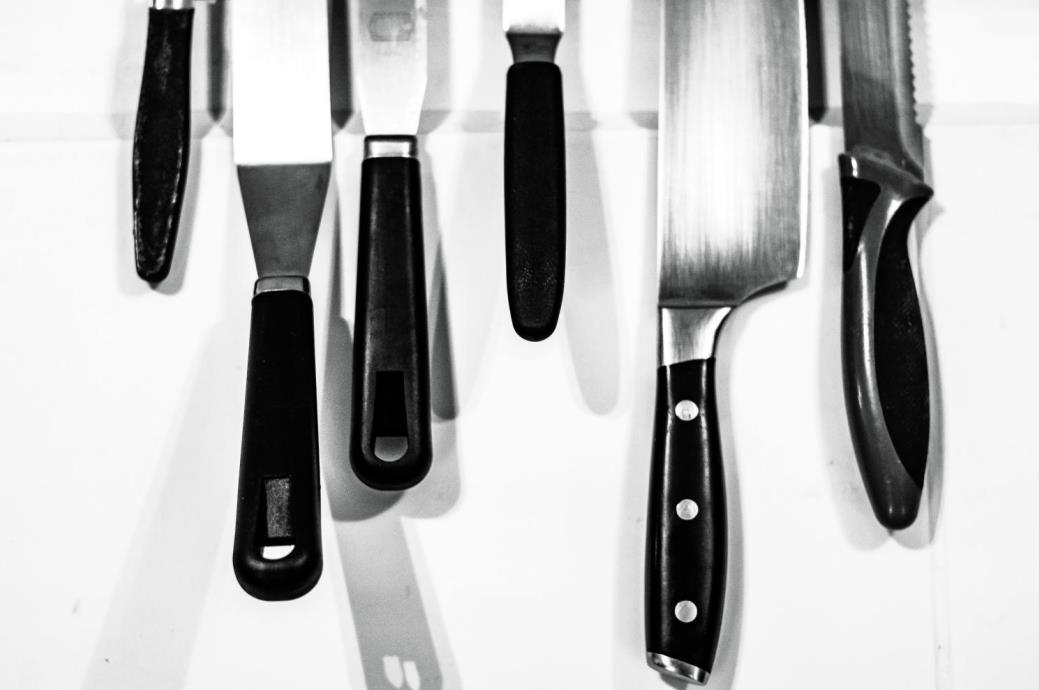
Japanese and German kitchen knives have entirely different handles. It’s not just the handle design but also the materials. Japanese kitchen knives feature octagonal or D-shaped, oval handles usually made from wood. This handle design is known as the wa-handle.
The shape of Japanese kitchen knife handles is comfortable to hold and provides great control over the blade. When delicately slicing or carefully dicing ingredients, the handle delivers easy movements, complementing each cut.
The handle scales are glued to the tang and secured with pins in German knives. Instead of the tang going inside the handle, German-style kitchen knives show it. The tang is visible from the spine to the end of the handle. The visible tang can tell if the blade is forged or stamped.
German knife handles don’t have a unified design. The handle has a curve and usually a bump at the end to ensure a solid grip. The German handle design ensures it stays in hand when chopping dense ingredients or cleaving bones.
Overall, Japanese handles enable more control over the blade, whereas German handles provide a firmer grip. There are Japanese kitchen knives with western handles. These knives match the needs of cooks that prefer Japanese blades but aren’t so fond of the traditional wa-handle.
Japanese vs. German knife design
It doesn’t take much to see the blade design differences between Japanese and German kitchen knives. Most German knife blades have a round design. For example, there isn’t a sharp transform into a triangular tip, and the belly usually has a curve to it.
We can say similar things for certain Japanese-style blades, like Gyuto and Santoku. However, these only make up a small number of Japanese kitchen knives. Kiritsuke, Yanagiba, Sujihiki, and many others come with a straight edge. The blade design is also fairly geometrical. For example, Kiritsuke and Yanagiba turn into a sharp triangular tip.
Additionally, Japanese kitchen knives are much thinner and lighter. They don’t have as much weight on the blade, putting less stress on the wrists when slicing. German knives, on the other hand, are heavier. Even the considerably big knives like the Yanagiba often weigh about 100 grams less than a typical German chef’s knife.
The extra weight isn’t always a downside, though. A heavy blade aids when chopping foods, doing some of the work for the cook – a perfect match for those that chop all day.
Bolster
German kitchen knives often feature a bolster, also known as the fingerguard. The bolster can go from the spine to the heel or cover half the blade. It shows the transition between the handle and blade while giving some degree of protection to the cook.
Japanese knives don’t have a bolster for several reasons. It adds weight to the blade, which is unfavorable for Japanese cooks. The tang also isn’t fitted with the handle all the way in. A small portion of the tang is visible with most Japanese knives, also keeping fingers away from the sharp edge.
Lastly, Japanese knives don’t need a bolster because the thinner handle keeps fingers away from the heel.
Tang
The slim handle design of Japanese kitchen knives means the tang isn’t as wide. There isn’t much material on the tang, shifting the balance of the knife towards the blade. However, this isn’t always the case. Short knives like the Santoku, Petty, and Honesuki have an even balance.
German knives have a wider and often heavier tang. When the knifemaker needs to reduce the weight, they cut a portion of it, making what we call the partial tang. These contribute to the weight of German kitchen knives, making them heavier overall.
Blade thickness
Japanese kitchen knives are usually thinner. Some are as slim as 1.5mm. In comparison, most German-style kitchen knives are about 3.5mm thick. Specific Japanese knives can also get as thick as this or even thicker. For example, Deba can be up to 9mm thick.
Overall, it depends on the type of knife, but Japanese blades are usually thinner than most other German kitchen knives.
Bevel difference
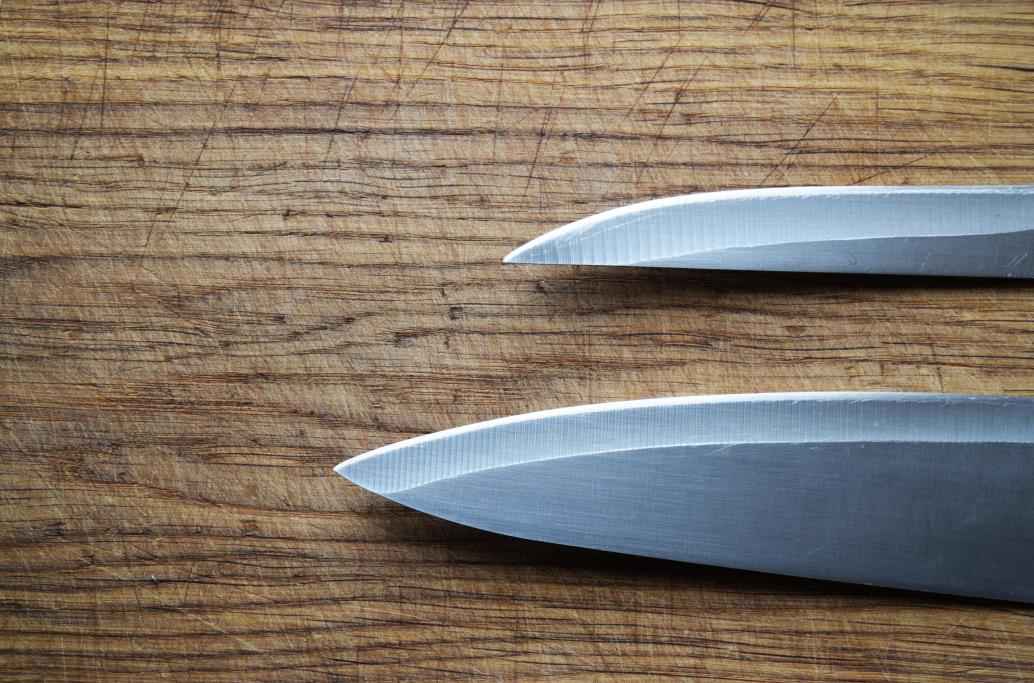
German-style kitchen knives are almost always ground on both sides, creating a double bevel. The same also applies to Japanese kitchen knives, but not all. Some Japanese kitchen knives – often the specialty blades – like the Yanagiba, Deba, and Honesuki are ground on only one side.
Japanese kitchen knives have a different grinding angle, even with double bevel blades. While most German kitchen knives are ground at about 20 degrees, Japanese alternatives are more acute at 10 to 15 degrees.
Single bevel knives have a different cutting style than those with a double bevel. They steer towards the ground side, so it’s extremely difficult to cut anything in a straight line. This is one of the reasons why Japanese chefs cut sashimi diagonally rather than linearly.
Forging technique and prices
Forging German kitchen knives is pretty straightforward. Take the steel, forge and shape the blade profile, heat treat, quench, temper, grind, polish, and put the handle on. There isn’t anything special that goes into it, which has a short lead time production.
It’s the same in most cases with Japanese kitchen knives, but certain forging techniques give special attributes to the blades. A good example of different forging techniques is the san mai construction.
Japanese knives require hard steel for better edge retention and sharpness. However, this also brings brittleness, making them prone to chipping. San mai is a construction method that produces a tougher blade.
In san mai blade construction, two layers of soft steel sandwich hard steel. After grinding, the hard steel makes the cuts, and the soft steel surrounding it gives the blade more durability.
If you want your order to feature specialized forging techniques, note that it will increase the production time as well as the price.
Final verdict
The takeaway from this comparison article is that Japanese kitchen knives are thin, lighter, and ideal for creating thin slices. German kitchen knives are much better at chopping, general cutting, and heavy-duty tasks.
Japanese have more specialized blades for specific cutting needs, like Nakiri for chopping vegetables and Deba for butchering fish. Although some German knives are forged with a specific purpose in mind, the number isn’t as many.
Most Japanese kitchen knives also hold a sharp edge for longer thanks to the hard knife steel used but are more likely to chip. German knife steels get dull faster but are much sturdier and more durable. It’s unlikely for a cook to chip the edge under continuous use. With Japanese knives, using the knife in accordance with its cutting style is vital to prevent damaging the blade.
Since Japanese and German kitchen knives bring a variety of blades, it’s best to compare them individually. For example, if you’re planning on selling vegetable cutting knives, comparing paring knives with the Japanese Petty or Nakiri will give you more insights.
Nonetheless, both Japanese and German knives are hot niche in a knife selling business, if you are interested in starting either one, contact us and get a free quota now. We provide a worldwide service for wholesale knife import, dropshipping, private labelling, and anything you can think of to scale up your business.
